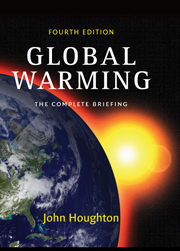Book contents
- Frontmatter
- Contents
- Preface
- 1 Global warming and climate change
- 2 The greenhouse effect
- 3 The greenhouse gases
- 4 Climates of the past
- 5 Modelling the climate
- 6 Climate change in the twenty-first century and beyond
- 7 The impacts of climate change
- 8 Why should we be concerned?
- 9 Weighing the uncertainty
- 10 A strategy for action to slow and stabilise climate change
- 11 Energy and transport for the future
- 12 The global village
- Appendix 1
- Appendix 2 Acknowledgements for figures, photos and tables
- Glossary
- Index
10 - A strategy for action to slow and stabilise climate change
- Frontmatter
- Contents
- Preface
- 1 Global warming and climate change
- 2 The greenhouse effect
- 3 The greenhouse gases
- 4 Climates of the past
- 5 Modelling the climate
- 6 Climate change in the twenty-first century and beyond
- 7 The impacts of climate change
- 8 Why should we be concerned?
- 9 Weighing the uncertainty
- 10 A strategy for action to slow and stabilise climate change
- 11 Energy and transport for the future
- 12 The global village
- Appendix 1
- Appendix 2 Acknowledgements for figures, photos and tables
- Glossary
- Index
Summary
FOLLOWING THE awareness of the problems of climate change aroused by the IPCC scientific assessments, the necessity of international action has been recognised. In particular, an Objective has been agreed to stabilise the concentrations of greenhouse gases in the atmosphere so as to eventually stabilise the climate. Nations or groups of nations are already pledging to substantial emissions reductions between now and 2050. What has yet to be agreed is the target level of stabilisation. In this chapter I discuss what target levels should be the aim and the actions that will be necessary to achieve them.
The Climate Convention
The United Nations Framework Convention on Climate Change (FCCC) signed by over 160 countries at the United Nations Conference on Environment and Development held in Rio de Janeiro in June 1992 came into force on 21 March 1994. It has set the agenda for action to slow and stabilise climate change. The signatories to the Convention (some of the detailed wording is presented in the box below) recognised the reality of global warming, recognised also the uncertainties associated with current predictions of climate change, agreed that action to mitigate the effects of climate change needs to be taken and pointed out that developed countries should take the lead in this action.
The Convention mentions one particular aim concerned with the relatively short-term and one far-reaching objective.
- Type
- Chapter
- Information
- Global WarmingThe Complete Briefing, pp. 290 - 324Publisher: Cambridge University PressPrint publication year: 2009



